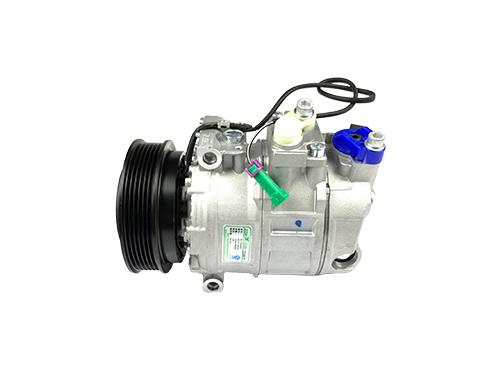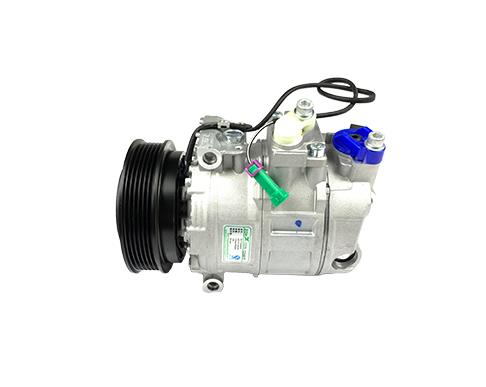
Understanding the Electrical Working Process of an Electric Vehicle's Air-Conditioning Compressor
Dive into the intricate workings of electric vehicle air-conditioning compressors. Explore the electrical processes, components, and innovations driving eco-friendly climate control in EVs.
ZHONGCHENGIn the realm of electric vehicles (EVs), one crucial component stands out for its role in ensuring passenger comfort and vehicle performance: the air-conditioning compressor. Unlike traditional internal combustion engine vehicles, EVs rely on an intricate electrical working process to power their air-conditioning systems efficiently. In this comprehensive guide, we delve into the intricacies of the air-conditioning compressor in electric vehicles, exploring its function, components, and operational mechanisms.
The Essence of an Air-Conditioning Compressor in Electric Vehicles
The air-conditioning compressor in electric vehicles serves a fundamental purpose: to regulate cabin temperature by circulating refrigerant throughout the system. Unlike its counterparts in conventional vehicles, which are typically driven by an engine belt, the air-conditioning compressor in an EV operates solely on electrical power. This crucial distinction underscores the significance of understanding its electrical working process.
The Core Components of an Electric Vehicle's Air-Conditioning Compressor
At the heart of every electric vehicle's air-conditioning system lies the compressor, a complex assembly comprising several key components:
1. Electric Motor: The electric motor serves as the powerhouse of the air-conditioning compressor, converting electrical energy from the vehicle's battery into mechanical energy. This energy drives the compression process, allowing the compressor to pressurize the refrigerant.
2. Refrigerant Circuit: Within the compressor, a closed-loop refrigerant circuit facilitates the transfer of heat, enabling the system to absorb heat from the cabin and release it outside. This circuit typically includes components such as evaporators, condensers, and expansion valves, all of which work in tandem with the compressor to regulate temperature effectively.
3. Control System: Modern electric vehicles are equipped with sophisticated control systems that govern the operation of the air-conditioning compressor. These systems utilize sensors and algorithms to monitor cabin temperature, battery status, and other relevant parameters, optimizing the compressor's performance for maximum efficiency and comfort.

The Electrical Working Process of the Air-Conditioning Compressor
The electrical working process of an electric vehicle's air-conditioning compressor can be broken down into several distinct stages, each of which plays a vital role in maintaining optimal cabin conditions:
Stage 1: Power Supply
The process begins with the vehicle's onboard battery supplying electrical power to the air-conditioning compressor. In most EVs, this power is drawn from the main traction battery, which provides the necessary voltage and current to drive the compressor's electric motor.
Stage 2: Motor Activation
Upon receiving electrical power, the compressor's electric motor springs into action, initiating the compression cycle. As the motor rotates, it drives the compressor's pistons or scroll mechanism, creating a vacuum that draws refrigerant vapor into the compression chamber.
Stage 3: Compression Cycle
Within the compression chamber, the refrigerant vapor is subjected to increasing pressure and temperature as it is compressed by the motor-driven pistons or scrolls. This compression process is essential for raising the refrigerant's temperature above ambient levels, facilitating efficient heat exchange within the air-conditioning system.
Stage 4: Heat Exchange
Once compressed, the high-pressure refrigerant flows through the system's condenser, where it releases heat to the surrounding environment. This heat exchange process causes the refrigerant to condense into a liquid state, ready for circulation back to the evaporator.
Stage 5: Cooling Cycle
The condensed refrigerant then travels to the system's evaporator, where it undergoes a phase change from liquid to vapor. This phase change absorbs heat from the cabin air, cooling it in the process. The now-vaporized refrigerant is then routed back to the compressor to begin the cycle anew.
Optimizing Efficiency and Performance
Efforts to enhance the electrical working process of air-conditioning compressors in electric vehicles are ongoing, driven by a desire to maximize energy efficiency and extend driving range. Innovations such as variable-speed compressors, improved refrigerant formulations, and advanced control algorithms are continually being developed to achieve these objectives.
Variable-Speed Compressors
One notable advancement in air-conditioning compressor technology is the widespread adoption of variable-speed compressors. Unlike traditional fixed-speed compressors, which operate at a constant RPM, variable-speed compressors can adjust their speed according to the cooling demands of the vehicle's cabin. This flexibility allows for precise temperature control and reduces energy consumption by matching compressor output to actual requirements.
Enhanced Refrigerant Formulations
Another area of innovation lies in the development of next-generation refrigerants with superior thermodynamic properties. These advanced formulations offer higher efficiency, lower environmental impact, and improved compatibility with electric vehicle air-conditioning systems. By optimizing refrigerant chemistry, manufacturers can enhance system performance while reducing greenhouse gas emissions.
Advanced Control Algorithms
The implementation of advanced control algorithms plays a pivotal role in optimizing the operation of electric vehicle air-conditioning compressors. By integrating real-time data from sensors throughout the vehicle, these algorithms can dynamically adjust compressor operation based on factors such as ambient temperature, cabin occupancy, and battery state of charge. This proactive approach ensures efficient utilization of electrical power while maintaining passenger comfort.
Conclusion
In conclusion, the electrical working process of an air-conditioning compressor in an electric vehicle is a multifaceted operation that combines cutting-edge technology with fundamental principles of thermodynamics. By understanding the core components, operational stages, and ongoing innovations in compressor design, manufacturers can continue to improve the efficiency, performance, and overall driving experience of electric vehicles. As the automotive industry continues its transition towards electrification, the role of the air-conditioning compressor will remain pivotal in shaping the future of sustainable transportation.
-
What are the effects of the two types of automobile air-conditioning compressors on fuel consumption and performance
 2021-04-14
2021-04-14
-
The main parts of automobile air-conditioning compressor: what is the electromagnetic clutch
 2021-04-14
2021-04-14






